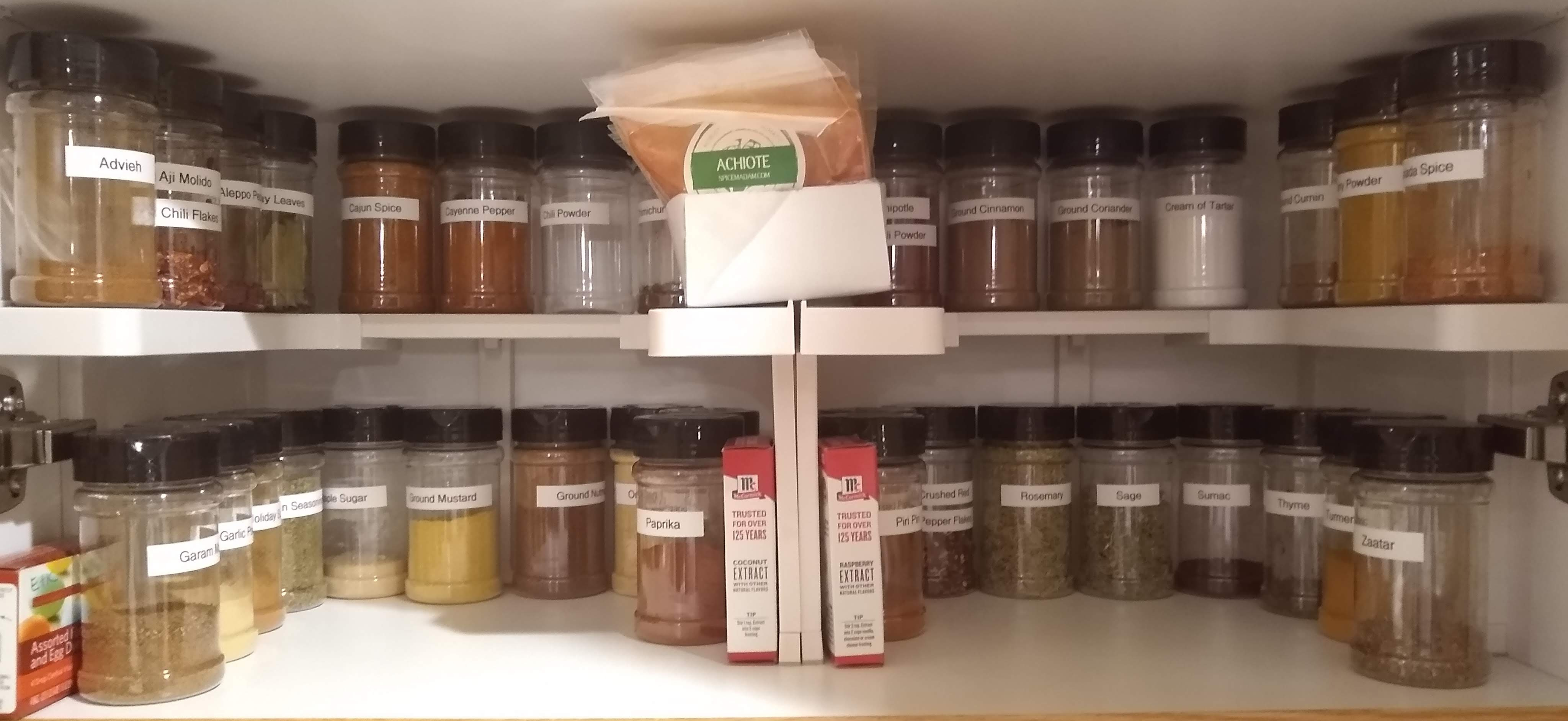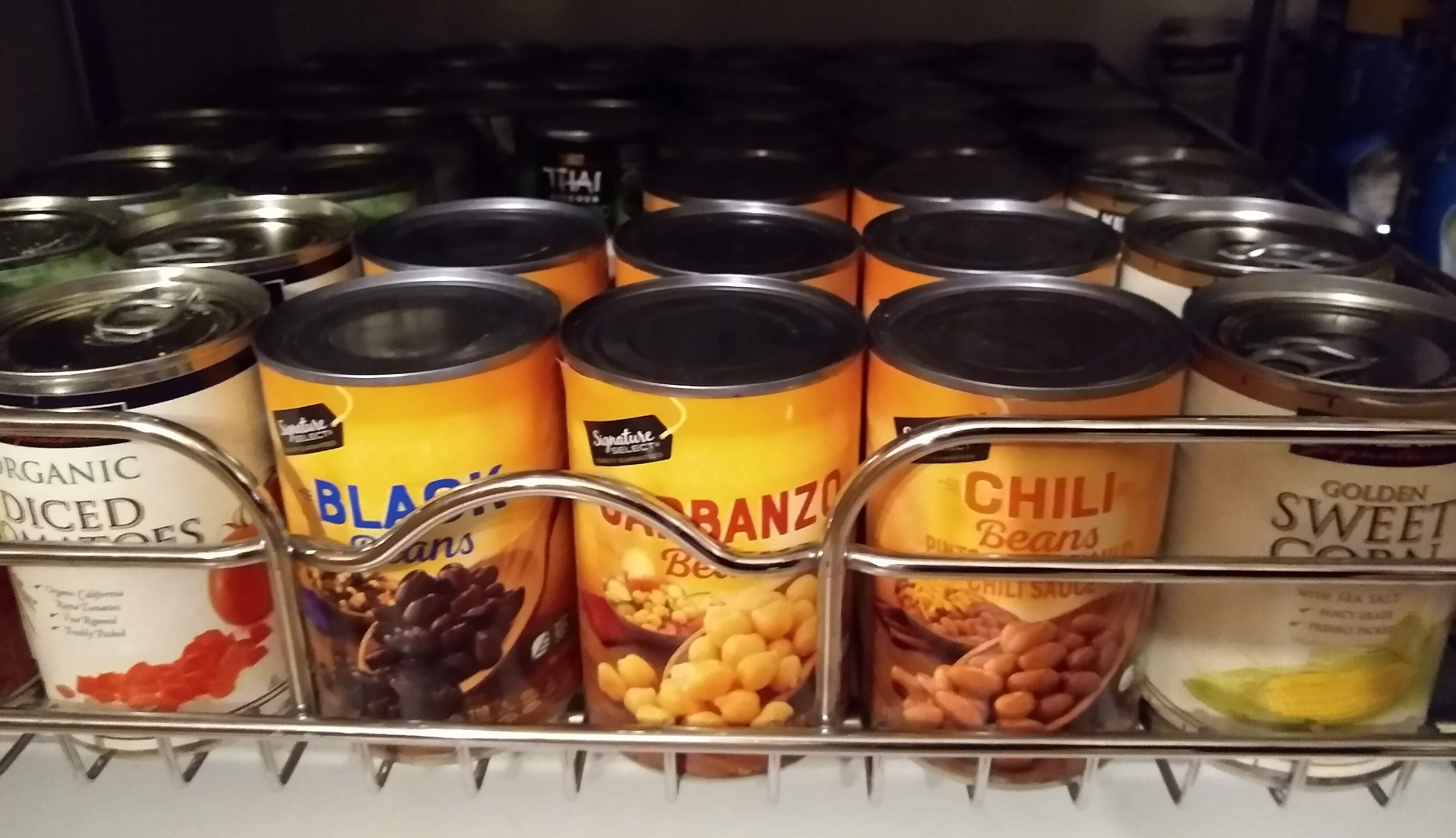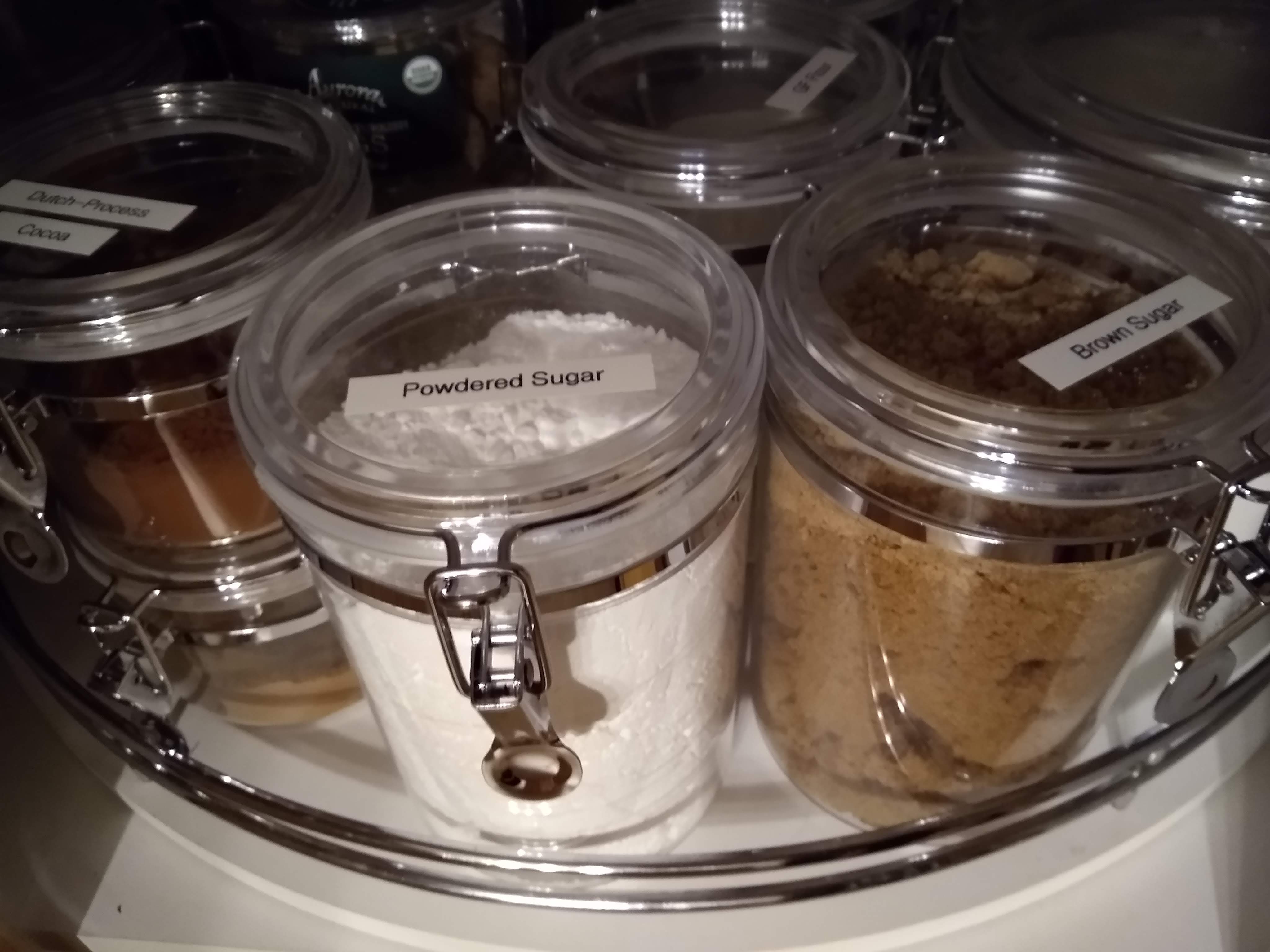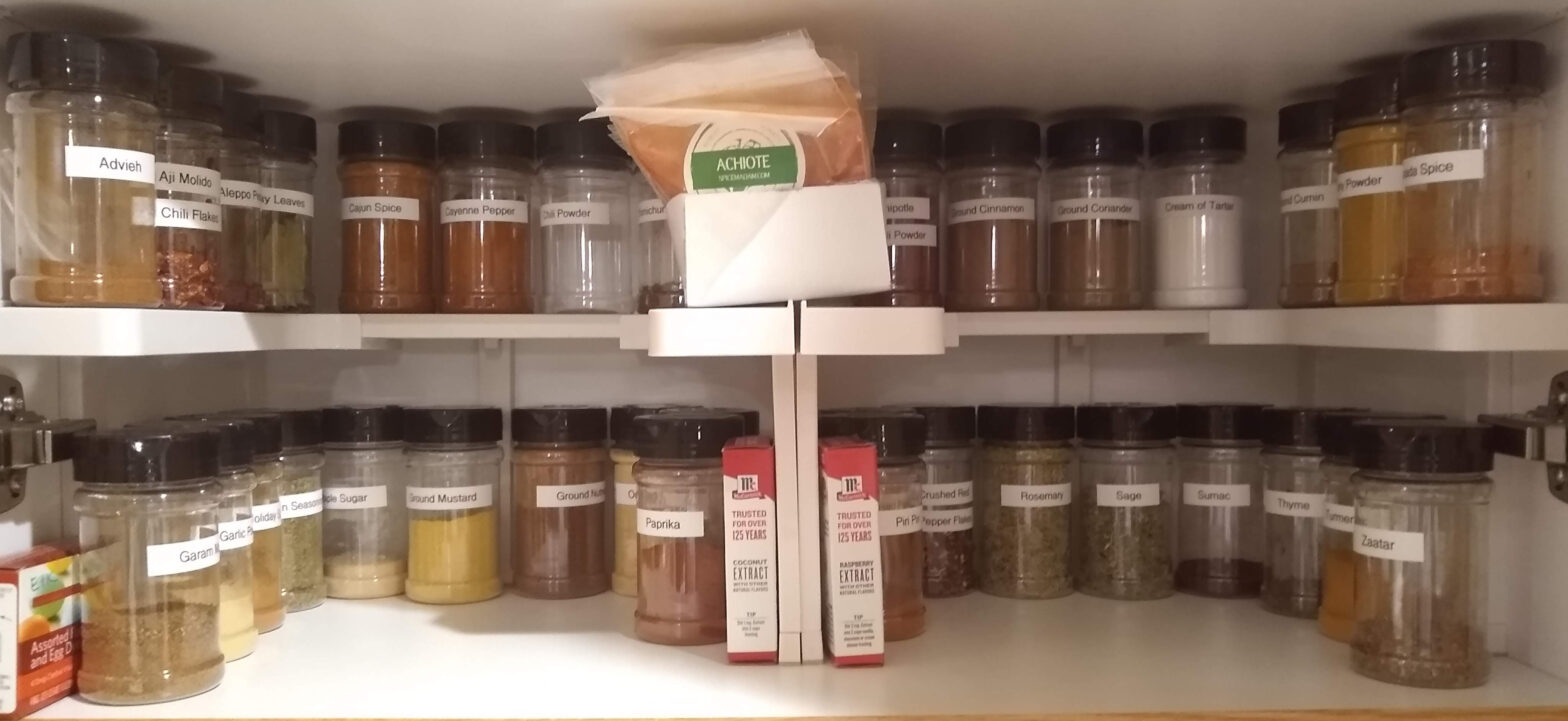You’ve heard us say it before: cooking is inherently easier when you have everything you need on hand. While it’s impractical to keep all ingredients on hand at all times, like meats, fruits, or vegetables, there are certain items that can and should be kept on hand at all times. We’ve put together a few lists of items that we suggest you have on hand, so if you’re just beginning to get into cooking and need some help on what to pick up to get started, refer to the lists below. We tried to include prices, types, quantities, and proper storage for each item where applicable.
Spices
While there are some spices that are common across cultures, spices ultimately will come down to what sorts of food you will be cooking. For example, if you are really into making Indian food, you will probably keep on hand many Indian spices as opposed to just a few basic ones that someone who rarely cooks Indian may have. However, we feel that the list below reflects a good variety of spices that should allow you to cook an an array of dishes without getting too much into the specialty spices.

Salt – Specifically, sea salt. If you’re properly seasoning your food, you should be using a fair amount of salt, so be sure to get stocked up at Costco with the pre-ground stuff (for salting water for pasta or potatoes) as well as the bigger crystals to be freshly ground for seasoning meat and veggies. You may also want to pick up Kosher salt. This salt is preferred by cooks who salt items by grabbing salt out of a container with their fingers. We personally don’t use a whole lot of Kosher salt unless we are making pretzels or focaccia, but it is good to have on hand.
Pepper – For the love of flavor, DO NOT buy the pre-ground stuff. Get a pepper grinder and some whole peppercorns to freshly grind as needed. The difference in flavor is immense, thank us later. Added bonus that when a recipe calls for whole peppercorns, you’ve got them!
Garlic Powder – Sometimes fresh garlic is good, but other times garlic powder is better (we like to use it on garlic bread so you don’t get a spicy bite of garlic). Costco is another good option here, or, surprisingly enough, places like Big Lots and Walmart have it for cheap as well.
Onion Powder – Just like garlic powder, sometimes fresh onion is what you’re looking for, but other times you want powder. This is great for rubs on meat or sprinkled over veggies before you roast them.
Cumin – This is what makes Mexican food taste Mexican. Add it to ground beef for tacos or sweet potatoes for a Mexican flair on a side dish.
Curry Powder – If you like curry, this is definitely something to keep on hand. It can also be added to almost anything and be a welcome flavor, such as roasted veggies or soups.
Bay leaves – Soups and stews frequently call for bay leaves. We have to admit that we haven’t done a taste test between a recipe with and without bay leaves, but we imagine there would be a noticeable difference. Look for a taste test in the future to prove or disprove this theory!
Cinnamon – Used most frequently in baking as opposed to cooking, cinnamon lends an earthy, warm note to dishes like coffee cakes, oatmeals, or even sprinkled on apples as a snack. We buy pre-ground here but you could also buy sticks and grind them yourself for similar benefits to fresh ground pepper.
Italian seasoning – If you’re not going to keep on hand every herb that comprises Italian seasoning (that would be basil, oregano, rosemary, thyme, sage, and coriander), definitely get a premade blend. This is perfect for pot pies, soups, and pastas.
Cooking Staples
Rice – You’ll likely want to keep both brown rice and white rice on hand, as they have different applications. You may also opt for other grains like quinoa and cous-cous. Rice does not go bad quickly, so get it in bulk to get the best price.

Canned veggies – Fresh veggies are wonderful, but not always what you are looking for in a recipe. We keep an array of canned veggies on hand at all times including kidney beans, black beans, tomatoes, chick peas, and corn. Having these on hand allows us to throw together a chili with a moment’s notice or make hummus when the mood strikes us. We grab most of our canned veggies at Costco. Any price less than a dollar a can is reasonable, but if you can find them under 80c a can, you’re getting a great deal.
Pasta – We always have pasta on hand so we can throw together a dinner in a pinch. We usually keep fettucine, medium shells, cavatappi, rotini, large elbows, and lasagna noodles on hand. Dried pasta doesn’t go bad very quickly, so it is something you can feel good about stocking up on. We usually buy Prince Pasta when it goes on sale for 88c a box. We have tried the store brand and have found that it is not nearly of the same quality as a name brand, so even though it is cheaper, we steer clear of it.
Pasta sauce – Of course to go with our pasta that we keep on hand, we have some sauces as well. We usually keep 2-3 jars each of red and white sauces. We usually wait for Classico or the store brand to go on sale for less than $1.99.
Oils – Used for frying, roasting, and finishing, oils are a key ingredient to almost anything you cook. We like to keep a variety on hand, including peanut, sesame, roasted walnut, and flavored olive oils, but at a minimum, you should have olive oil and canola oil. Oils do age, so you don’t want to buy too much at a time, but buying in bulk does save you some money on something that isn’t the cheapest – nor do you want it to be, cheap oils can have a funky taste.
Vinegars – When a dish needs an acidic punch, vinegars are a great addition. We suggest having lots of white vinegar on hand for not only cooking, but also cleaning purposes (specifically for wooden cutting boards, as we describe in our wooden cutting board care post, but it can be used to clean most anything). We also keep apple cider vinegar, balsamic vinegar, red wine vinegar, and rice wine vinegar on hand, though those are optional. You may observe a cloudiness to your vinegar if you keep it around long enough. This does not mean it has gone bad – it has just developed what is called “The Mother”.
Bread crumbs – Whether you’re using them to solidify a meatloaf, to add a crunchy topping to mac n cheese, or to bread chicken, breadcrumbs have a variety of uses and don’t go bad very quickly. We usually keep a few kinds on hand, including panko, plain, and seasoned, but just plain will do most of what you need and can always be seasoned with spices if needed.
Baking Staples
Flour – If you ever want to bake when the urge strikes you, you’ve got to keep flour on hand. We keep unbleached all-purpose flour, bread flour, and cake flour on hand. It’s important to keep your flour safe from bugs by storing it in an air-tight container. We usually buy the store brand (we did a taste test and didn’t notice a huge difference from the name brand) in 5 or 10 lb bags, but during the pandemic we got a 50lb bag from Costco and it lasted us quite a while without spoiling, so that is an option as well if you have the room to store such a huge quantity.
Sugar – We keep white granulated sugar, dark brown sugar (never light brown sugar), and powdered sugar on hand. We buy the store brand when they go on for $1.88. It’s imperative if you don’t want a brick of brown sugar to store it in an air-tight container. Some will add what is called a Brown Sugar Bear to keep brown sugar from clumping, but we have never had to do that with ours. We also keep maple sugar on hand, but we don’t consider that a necessity (regardless of how delicious it is!).

Cocoa – Like things chocolatey? Then you’ve got to keep some sort of cocoa on hand. For most circumstances, unsweetened baking cocoa will do it, but we also keep Dutch process cocoa and raw cacao powder on hand.
Oats – A common cookie base or breakfast staple, oats have a variety of uses. We usually buy old fashioned oats (just the store brand) in bulk and keep them in an air-tight container. Are you noticing a trend? Air-tight containers are a must. We use the Oggi line of air-tight containers and love them because they are clear so you know how much you have left.
Nuts and Raisins – We always have chopped pecans, walnuts, almonds, and raisins in our baking cabinet for cookies or to put on top of ice cream. Be sure not to buy more nuts than you will reasonably use in the near future as they can grow stale, even when kept in an air-tight container. Also consider the way you use these items – if you’re constantly needing slivered almonds, don’t buy whole ones! Typically whole nuts are cheaper than their pre-chopped counterparts, but sometimes it is worth that extra money to get the specific cut you use most often.
Chocolate chips – We grab our semi-sweet chocolate chips from Costco. Chocolate chips are something that will bloom over time (turn white on the outside), but this does not mean they have gone bad – so don’t hesitate to still use them. When they melt in cookies, you will never know the difference. We also typically have white chocolate chips on hand as well to make Cotton Soft Japanese Cheesecake, a recipe that we got from our Japan Spice Madam box in June of 2019.
Honey and/or maple syrup – When a dish needs sweetness, of course you can use sugar, but sometimes the added flavors or liquid consistency of maple syrup or honey can work better than plain granulated sugar. And being from Vermont, we have to have maple syrup on hand at all times or else we’d be run out of town! A good price in Vermont for maple syrup is anything around $40/gallon. We suggest getting Grade A Amber or Grade A Dark for a more intense maple flavor, but maple syrup grade is definitely a personal preference thing, so taste each grade and figure out which is your favorite.
Peanut butter – Unless you’re allergic to peanut butter, we strongly suggest you keep some in your house always (smooth is our preference here, but if you’re into crunchy, we won’t judge!). It’s a great vegetarian protein source and can make great cookies. Also, if you warm it up for a bit in the microwave until it becomes liquid, then pour it on top of some ice cream, it will harden into a peanut butter shell sundae that is way tastier than you can imagine.
Vanilla extract – A baking must. But don’t go out and buy it at the grocery store unless you like being soaked for way more money than you need to spend. Make it yourself! Recipe here.
Leaveners – Baking powder, baking soda, and yeast. Having each of these on hand will allow you to put together a bread, cake, or cookie with a moment’s notice. We keep both active dry and instant yeast on hand, stored in the fridge for a longer shelf life.
Fridge
Eggs – Eggs typically have a reasonably long shelf life, and so we typically have at least 6 on hand at all times. We love getting our eggs on sale for 88c/dozen, but anything under $1.50 a dozen isn’t a bad price. We don’t discriminate between brown and white eggs, but we have had fresh eggs from a local farmer, and they make a WORLD of difference. If you are fortunate enough to be able to get fresh eggs on the regular, you should. If not, at least go out of your way to use local eggs when making items that really let the egg shine, such as in pound cakes, custards (including homemade ice cream), and flans.
Milk – Assuming you drink milk, you probably already have this on hand. Due to its shorter shelf life, if you aren’t one to use milk daily, you probably shouldn’t keep this on hand unless you have a plan to use it in something. We always have 2% in our house as well as at least one non-dairy milk as I am technically lactose intolerant (I don’t let it stop me from enjoying all types of dairy though!). Typically we grab almond milk, but have also experimented with oat milk and soy milk as well. We have found that the store brand non-dairy milks are actually usually better tasting and cheaper than the name brands.
Hot sauce – You don’t have to be a spicy-food connoisseur to have a hot sauce in your house. There are many recipes that call for just a touch of it to add to the flavor. It’s good to have at least something on hand for those instances or if you have a friend or family member over who does like to use hot sauce. We always have sriracha, Frank’s, and a variety of hotter sauces as well.
Worcester sauce – Ok, ok, it’s really called Worcestershire sauce, but that’s a mouthful and no one really knows how to pronounce it, so if you’re from Vermont, there’s no shame in renaming it Worcester sauce. No one outside of Vermont knows how to pronounce that, either. You’ll use this rarely, but when you need it, you need it. It’s a salty kick that’s used frequently in marinades or sauces that just don’t turn out nearly the same without it.
Citrus juice – Both lemon and lime. These are great for adding to sliced apples to keep them from browning are also key in things like hummus and marinades.
Soy sauce – A staple in Asian cuisine, soy sauce is salt but better. Perfect for sushi or other Asian-inspired marinades and sauces.
Better Than Bouillon – Yes, we are recommending a product by name. If you don’t make your own stock, this stuff is the next best thing. You don’t have to find room to store jars or boxes of premade stock, and it’s ready to use in seconds. Just add some to water, and it’s good to go. We keep Costco containers of veggie, chicken, and beef on hand and find that we use them most frequently in that order.
Condiments – Salad dressings, ketchup, mayo, barbeque sauce, mustard… You probably already have these because they are just so well used, not only for dipping and dressing, but as an ingredient within other things like Spinach-Artichoke Dip or homemade barbeque sauces. We also include Pickled Red Onions in this category.
Freezer
Meat – When meat goes on a good sale, don’t buy just what you need for that week and no more. Take full advantage of the deal and freeze whatever you don’t immediately use. Meat freezes beautifully, and then when there comes a week when no meat is on sale, you can pull from your freezer. We usually always have at least some of each of these in our freezer at all times: ground beef, steak tips, chicken breast, chicken thighs, and lamb.
Frozen Veggies – Sometimes frozen is better than fresh or canned. We typically stock peas and mixed veggies in our freezer for adding to mac n cheese or pot pies. We get the store brand when they go on for 99c or less.
Herbs – We’ve all been there, a recipe calls for 2 mint leaves, and if you have a brown thumb like us, you have to buy a whole package of them. What do you do with the remaining leaves so they don’t go to waste? Freeze them. You can choose to chop them before freezing or freeze them whole. Next time you need mint, you’re not stuck buying a whole new package, just pull some from your freezer. The only downside is that they won’t look as pretty as they did fresh, so they won’t be appropriate for garnish once frozen, but their taste will remain the same. We do this with parsley, cilantro, and dill.
Butter – Yes, you can freeze butter! We do this all the time when the store brand goes on for $1.77 or less for a pound of unsalted butter. We buy unsalted as you can always add salt if you need it separately. We usually have 3-4 pounds (12-16 sticks) in the freezer, 1 pound (4 sticks) in the fridge, and 1-2 sticks at room temperature, so if you want to make that recipe that calls for softened butter, you’re not stuck waiting for your butter to be ready (and you’re not tempted to use the microwave to soften butter – which never works! It just melts it).
Cheese – Yes, you can freeze cheese, too! We always have shredded cheese in our freezer. Whether it’s a good deal on the store brand ($1.77/lb) or a big bag from Costco, we always have cheddar and mozzarella in our freezer. You can pull it out into the fridge as you need it, or use it straight from the freezer. So long as you’re melting it, it’ll be just as good.
Bread – Bread is something we keep on hand at all times in case we run out of food and need to make sandwiches. However, unless we are planning on using it as part of our meals for the week, we can’t keep it in the pantry or else it will mold before we can use it. So we freeze it! We’ve always got a few loaves in the freezer and a partial loaf in the fridge for emergencies. We really love Arnold’s Oatnut bread, but whatever floats your boat.
Breakfast sandwiches – If you haven’t read our post on breakfast sandwiches yet, this won’t make a whole lot of sense, but we keep at least a dozen on hand in the freezer for a quick breakfast if we don’t have other things in the house to eat.
Bacon – Like breakfast sandwiches, unless you’ve read our post on bacon, this may not make a lot of sense, but we always have at least a pound of cooked bacon in the freezer.
Cookies – You know when you just really want a cookie but don’t really want 2 dozen cookies? This is how you do it. Make your cookie dough, bake up what you want, freeze the rest of the dough, already in little cookie-sized balls, for later. When you want a cookie, take as many dough balls out of the freezer as you like, stick them on a baking tray, and bake them up. They make take a little extra time than the fresh dough did, but they will come out just as good!
Having each of these ingredients on hand provides you with a large variety of meals you can make without having to go to the store. You’ve got bread, cheese, and butter? Make a grilled cheese! Have canned veggies? Throw together a chili. You have yeast, flour, and sugar? Make a loaf of Old Fashioned Amish Bread to go with it. And if you’re ever caught with leftover fresh veggies and you’ve got eggs – make a quiche to use them up! Maybe you don’t need a quiche this week, so freeze it in individual portions for quick breakfasts next month! The possibilities with a well stocked kitchen are endless!
Did we miss a key ingredient you never go without? Let us know in the comments!

